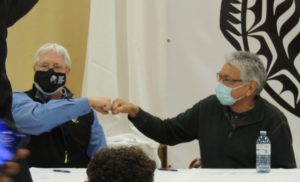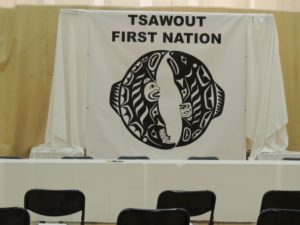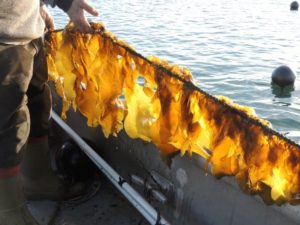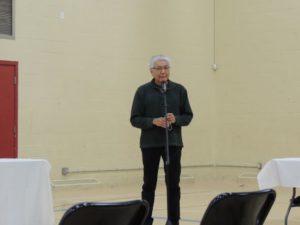
Signing Ceremony Cementing Partnership Between Tsawout First Nation and Cascadia Seaweed
By John Gailus, Kajia Eidse-Rempel and
Erica Fritch
On Friday, February 25, 2022, members of DGW Law joined Tsawout First Nation Chief and Council, Elders and members, Cascadia Seaweed, the public and media for a signing ceremony that cemented a partnership between Tsawout First Nation (“Tsawout”) and Cascadia Seaweed. The partnership was made possible after the Tsawout Marine Use Law (the “Law”) came into effect in June 2021.
Cascadia Seaweed (“Cascadia”) approached Tsawout in early 2021 with a proposal for the company to set up a seaweed farm in Tsawout marine territory. Rather than seek provincial approvals for its water lot, Cascadia was prepared to proceed with the consent of the Nation. This approach was a significant recognition of Tsawout’s jurisdiction. Tsawout Chief and Council, with the legal advice and drafting support of DGW Law lawyers John Gailus and Kajia Eidse-Rempel, used this unique and historic opportunity to draft their own Law to take back jurisdiction over their marine territory.
As part of the gathering, DGW Law co-founder and University of Victoria Adjunct Professor John Gailus spoke about the significance of the Marine Use Law by giving a brief history lesson. The signing ceremony took place 170 years and one week after the W̱SÁNEĆ people and Governor James Douglas, on behalf of the British Crown, entered into the North Saanich Treaty (also referred to as the Douglas Treaty). The treaty was not a granting of rights but a recognition and guarantee of Tsawout’s (and other W̱SÁNEĆ Nations’) pre-existing rights, including among others, the right to “carry on our fisheries as formerly”
Governor Douglas summarised the treaty promises, when reporting back to his superiors in Britain, by saying “I informed the natives […] that they were at liberty to hunt over unoccupied lands, and to carry on their fisheries with the same freedom as when they were the sole occupants of the country.” This solemn treaty promise has been breached time and time again by both federal and provincial Crowns.
The Saanichton Marina case, in which Tsawout successfully halted the construction of a marina that would have destroyed a significant Tsawout fishery, confirmed that the term “fishery” signifies not only the right to catch fish but also the connection of that right to the places where Tsawout members exercise it.[1]
Tsawout continues to assert its inherent right to govern, manage and protect its fisheries for future generations.
Recent incremental changes in the law as well as the governments’ embrace of the United Nations Declaration on the Rights of Indigenous Peoples (UNDRIP) have opened a world of possibilities for Indigenous Nations. With growing public awareness and support for the rights of Indigenous communities, and companies like Cascadia taking initiative to develop respectful, progressive business practices that go beyond the minimal and insufficient governmental requirements, the time is ripe for this Law and for Tsawout to have a meaningful say over what occurs in its marine territory.
Bill Collins, Cascadia Chairman, shared that he was honoured and humbled to be partnering with Tsawout. He spoke to those gathered about the importance of addressing climate change through innovation, the fact that Cascadia’s work cannot be done in isolation, and the importance of the hand-in-hand approach with the Nation. Beyond working with local Nations, Cascadia plans to create and store seaweed bio-stock for future use and to re-establish levels of biodiversity in Vancouver Island’s surrounding waters that match pre-industrial levels. This includes seaweed and the many species of fish and marine mammals that inhabit kelp forests.
Tsawout Elder Mavis Underwood, who was on Council when talks with Cascadia started, spoke of the Law and the partnership as being about a way of life and creating an ecosystem that supports life. She also spoke of the work Cascadia and Tsawout are doing as having the power to inspire the young people, to ensure there is a sustainable place in their community for them in the future. She has been asked by Cascadia to act as an advisor, ensuring traditions will be maintained and revitalized.
Tsartlip First Nation (Tsawout’s close neighbour) Chief Don Tom also spoke at the gathering, saying that this important work is not just a practice of fishing maintenance but of the health of the environment and practices that are taking carbon out of the environment. It is a courageous step for Tsawout to reassert jurisdiction and remind government and the public that the Nation exercises authority over its marine territory and has a say over what activities are authorized within it.
After the ceremony, Cascadia and Tsawout marine workers took attendees on boats to visit the seaweed farm near ȽEL¸TOS (James Island, over which Tsawout has treaty rights and Aboriginal title) to see the underwater farm, pull up ropes of baby seaweed planted in November and taste two types of seaweed that are currently growing.
The significance of Tsawout’s Marine Use Law cannot be overstated. It is the first of its kind in British Columbia. It is a significant steppingstone for Tsawout and a key precedent for Indigenous Nations throughout Canada to reconcile treaty promises and Indigenous jurisdiction with the Crown’s jurisdiction.
[1] Saanichton Marina v. Claxton, 1989, CanLII 2721 (BCCA).
Featured image: Chief Harvey Underwood and Cascadia Seaweed’s Bill Collins after signing an agreement between Tsawout and Cascadia



